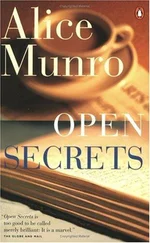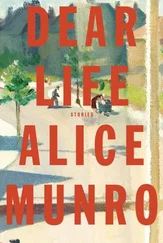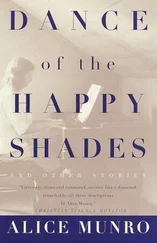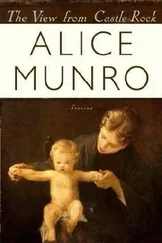But Roy never found out what those things were. Her strength had taken a slump that she could not recover from. And that seemed to bring about a profound change in her personality. Visitors made her nervous-her family more than anybody. She felt too tired for conversation. She didn’t want to go out. She kept up the house adequately, but she rested between chores so that simple routines took her all day. She lost most of her interest in television, though she would watch it when Roy turned it on, and she lost also her rounded, jolly figure, becoming thin and shapeless. The warmth, the glow-whatever had made her nice looking-were drained out of her face and her brown eyes.
The doctor gave her some pills but she couldn’t tell whether they did her any good or not. One of her sisters took her to a practitioner of holistic medicine, and the consultation cost three hundred dollars. She could not tell if that did her any good either.
Roy misses the wife he was used to, with her jokes and energy. He wants her back, but there’s nothing he can do, except be patient with this grave, listless woman who sometimes waves her hand in front of her face as if she is bothered by cobwebs or has got stuck in a nest of brambles. Questioned about her eyesight, however, she claims that it is fine.
She no longer drives her car. She no longer says anything about Roy going to the bush.
She may snap out of it, Diane says. (Diane is about the only person who still comes to the house.) Or she may not.
That is pretty well what the doctor said, in a lot more careful words. He says that the pills he’s got her on will keep her from sinking too low. How low is too low, Roy thinks, and when can you tell?
Sometimes he finds a bush that the sawmill people have logged out, leaving the tops on the ground. And sometimes he finds one where the forest management people have gone in and girdled the trees they think should come out because they are diseased or crooked or no good for lumber. Ironwood, for instance, is no good for lumber, and neither is hawthorn or blue beech. When he spots a bush like this he gets in touch with the farmer or whoever owns it, and they bargain, and if the payment is agreed on he goes in to get the wood. A lot of this activity happens in the late fall-now, in November, or early December-because that is the time for selling firewood and because it is the best time for getting his truck into the bush. Farmers nowadays don’t always have a well-travelled lane going back there, as they did when they cut and hauled wood themselves. Often you have to drive in across the fields, and this is possible only at two times during the year-before the field is plowed and after the crop is off.
After the crop is off is the better time, when the ground is hardened by frost. And this fall the demand for wood is greater than ever, and Roy has been going out two or three times in one week.
Many people recognize trees by their leaves or by their general shape and size, but walking through the leafless deep bush Roy knows them by their bark. Ironwood, that heavy and reliable firewood, has a shaggy brown bark on its stocky trunk, but its limbs are smooth at their tips and decidedly reddish. Cherry is the blackest tree in the bush, and its bark lies in picturesque scales. Most people would be surprised at how high cherry trees grow here-they are nothing like the cherry trees in fruit orchards. Apple trees are more like their orchard representatives-not very tall, bark not so definitely scaled or dark as the cherry’s. Ash is a soldierly tree with a corduroy-ribbed trunk. The maple’s gray bark has an irregular surface, the shadows creating black streaks, which meet sometimes in rough rectangles, sometimes not. There is a comfortable carelessness about that bark, suitable to the maple tree, which is homely and familiar and what most people think of when they think of a tree.
Beech trees and oaks are another matter-there is something notable and dramatic about them, though neither has as lovely a shape as the big elm trees which are now nearly all gone. Beech has the smooth gray bark, the elephant skin, which is usually chosen for the carving of initials. These carvings widen with the years and decades, from the slim knife groove to the blotches that make the letters at last illegible, wider than they are long.
Beech will grow a hundred feet high in the bush. In the open they spread out and are as wide as high, but in the bush they shoot up, the limbs at the top will take radical turns and can look like stag horns. But this arrogant-looking tree may have a weakness of twisted grain, which can be detected by ripples in the bark. That’s a sign that it may break, or go down in a high wind. As for oak trees, they are not so common in this country, not so common as beech but always easy to spot. Just as maple trees always look like the common necessary tree in the backyard, so oak trees always look like trees in storybooks, as if, in all the stories that begin, “Once upon a time in the woods,” the woods were full of oak trees. Their dark, shiny, elaborately indented leaves contribute to this look, but they seem just as legendary when the leaves are off and you can see so well the thick corky bark with its gray-black color and intricate surface, and the devilish curling and curving of the branches.
Roy thinks that there is very little danger in going tree cutting alone if you know what you are doing. When you are going to cut down a tree, the first thing is to assess its center of gravity, then cut a seventy-degree wedge, so that the center of gravity is just over it. The side the wedge is on, of course, determines the direction in which the tree will fall. You make a falling cut, from the opposite side, not to connect with the wedge cut but in line with its high point. The idea is to cut through the tree, leaving at the end a hinge of wood which is the very center of the tree’s weight and from which it must fall. It is best to make it fall clear of all other branches, but sometimes there is no way this can happen. If a tree is leaning into the branches of other trees, and you can’t get a truck into position to haul it out with a chain, you cut the trunk in sections from beneath, till the upper part drops free and falls. When you’ve dropped a tree and it’s resting on its branches, you get the trunk to the ground by cutting through the limb wood until you come to the limbs that are holding it up. These limbs are under pressure-they may be bent like a bow-and the trick is to cut so that the tree will roll away from you and the limbs won’t whack you. When it is safely down, you cut the trunk into stove lengths and split the stove lengths with the ax.
Sometimes there’s a surprise. Some squirrelly wood blocks can’t be split with the ax; they have to be laid on their sides and ripped with a chain saw; the sawdust cut this way, with the grain, is taken away in long shreds. Also, some beech or maple has to be side split, the great round chunk cut along the growth rings on all sides until it is almost square and can be more easily attacked. Sometimes there’s dozy wood, in which a fungus has grown between the rings. But in general the toughness of the blocks is as you’d expect-greater in the body wood than in the limb wood, and greater in the broad trunks that have grown up partly in the open than in the tall slim ones that have pushed up in the middle of the bush.
Surprises. But you can be prepared for those. And if you’re prepared, there’s not the danger. He used to think of explaining all this to his wife. The procedures, the surprises, the identification. But he couldn’t think of the way to go about it, so that she’d be interested. Sometimes he wished he had got around to passing on his knowledge to Diane when she was younger. She would never have the time to listen now.
And in a way his thoughts about wood are too private-they are covetous and nearly obsessive. He has never been a greedy man in any other way. But he can lie awake nights thinking of a splendid beech he wants to get at, wondering if it will prove as satisfactory as it looks or has some tricks up its sleeve. He thinks of all the woodlots in the county that he has never even seen, because they lie at the backs of farms, behind private fields. If he is driving along a road that goes through a bush, he swings his head from side to side, afraid of missing something. Even what is worthless for his purposes will interest him. A stand of blue beech, for instance, too delicate, too weedy, to bother with. He sees the dark vertical ribs slanting down the paler trunks-he will remember where these are. He would like to get a map in his mind of every bush he sees, and though he might justify this by citing practical purposes, that wouldn’t be the whole truth.
Читать дальше












